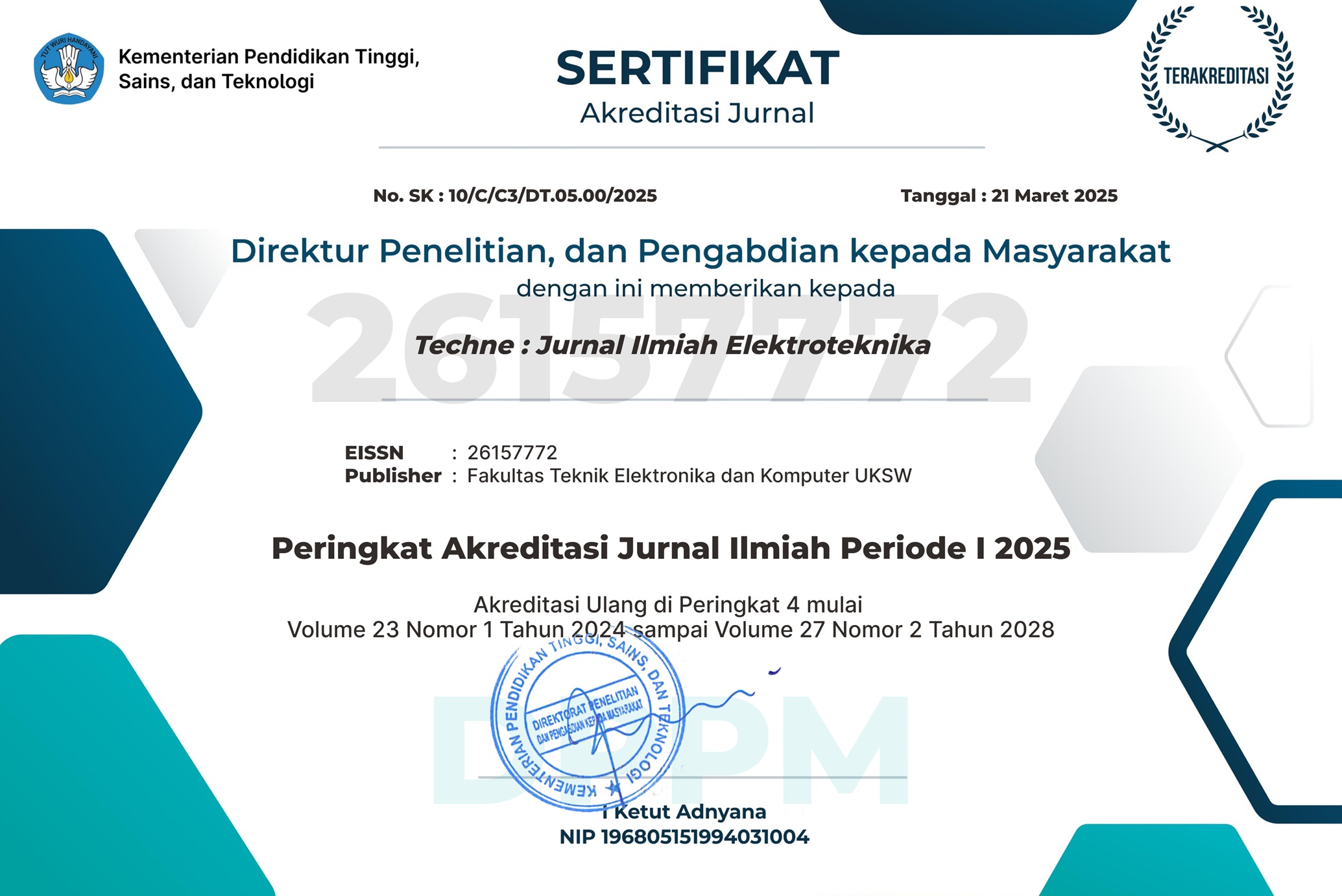Optimizing Performance of AdaBoost Algorithm through Undersampling and Hyperparameter Tuning on CICIoT 2023 Dataset
DOI:
https://doi.org/10.31358/techne.v23i2.467Keywords:
AdaBoost, GridSearchCV, IoT, UndersamplingAbstract
The increasing prevalence of the Internet of Things (IoT) in various sectors presents new challenges related to security and protection against cyberattacks. The connection of IoT devices to the Internet network makes them vulnerable to various types of attacks. One approach to attacking IoT devices is to perform analysis based on network traffic using machine learning algorithms such as AdaBoost. An IoT device attack prediction model was created for the purpose of predicting IoT device attacks based on network traffic. Based on research and discussion regarding optimization of the n_estimator value and algorithm in the AdaBoost algorithm on the CICIoT 2023 dataset that has been undersampled and using the grid search cv method, the most optimal n_estimator value is 500 and the most optimal algorithm value is SAMME with an accuracy rate of 0.78 and a recall value of 0.78. This optimization underscores the significance of finetuning parameters in machine learning algorithms to enhance the effectiveness of cybersecurity measures for IoT devices.
Downloads
References
C. Lee and G. Ahmed, “Improving IoT Privacy, Data Protection and Security Concerns,” International Journal of Technology, Innovation and Management (IJTIM), vol. 1, no. 1, pp. 18–33, Sep. 2021, doi: 10.54489/ijtim.v1i1.12.
U. Inayat, M. F. Zia, S. Mahmood, H. M. Khalid, and M. Benbouzid, “Learning-Based Methods for Cyber Attacks Detection in IoT Systems: A Survey on Methods, Analysis, and Future Prospects,” Electronics (Basel), vol. 11, no. 9, p. 1502, May 2022, doi:
3390/electronics11091502.
S. Kato, Tanabe Rui, K. Yoshioka, T. Matsumoto, “Adaptive observation of emerging cyber attacks targeting various IoT devices,” in 2021 IFIP/IEEE International Symposium on Integrated Network Management (IM), pp. 143–151, 2021.
N. Agrawal, S. Tapaswi, “Defense mechanisms against DDoS attacks in a cloud computing environment: state-of-the-art and research challenges,” IEEE Communications Surveys and Tutorials, vol. 21, no. 4, pp. 3769–3795, Oct. 2019, doi: 10.1109/COMST.2019.2934468.
A. Banitalebi Dehkordi, M. R. Soltanaghaei, F. Z. Boroujeni, “The DDoS attacks detection through machine learning and statistical methods in SDN,” Journal of Supercomputing, vol. 77, no. 3, pp. 2383–2415, Mar. 2021, doi: 10.1007/s11227-020-03323-w.
P. L. W. E. Putra, C. A. Sari, and F. O. Isinkaye, “Secure text encryption for IoT communication using affine cipher and diffie-hellman key distribution on arduino atmega2560 IoT devices,” Jurnal Teknik Informatika (Jutif), vol. 4, no. 4, pp. 849–855, Aug. 2023, doi: 10.52436/1.jutif.2023.4.4.1129.
S. M. Tahsien, H. Karimipour, and P. Spachos, “Machine learning based solutions for security of Internet of Things (IoT): A survey,” Journal of Network and Computer Applications, vol. 161, p. 102630, Jul. 2020, doi: 10.1016/j.jnca.2020.102630.
N. Patil, “Using machine learning in detecting IoT cyber attacks,” Int J Res Appl Sci Eng Technol, vol. 10, no. 11, pp. 472–478, Nov. 2022, doi: 10.22214/ijraset.2022.47365.
E. C. P. Neto, S. Dadkhah, R. Ferreira, A. Zohourian, R. Lu, A. A. Ghorbani, “CICIoT2023: A real-time dataset and benchmark for large-scale attacks in IoT environment,” Sensors, vol. 23, no. 13, p. 5941, Jun. 2023, doi: 10.3390/s23135941.
K. Bobrovnikova, S. Lysenko, P. Popov, D. Denysiuk, A. Goroshko, “Technique for IoT cyberattacks detection based on the energy consumption analysis,” in International Workshop on Intelligent Information Technologies & Systems of Information
Security, 2021. Accessed: Oct. 23, 2023. [Online]. Available: https://api.semanticscholar.org/CorpusID:233432271
A. Nugraha and J. Zeniarja, “Malware Detection Using Decision Tree Algorithm Based on Memory Features Engineering,” Journal of Applied Intelligent System, vol. 7, no. 3, pp. 206–210, Dec. 2022, doi: 10.33633/jais.v7i3.6735.
D. Tang, L. Tang, R. Dai, J. Chen, X. Li, J. J. P. C. Rodrigues, “MF-Adaboost: LDoS attack detection based on multi-features and improved Adaboost,” Future Generation Computer Systems, vol. 106, pp. 347–359, May 2020, doi: 10.1016/j.future.2019.12.034.
M. M. Kholil, F. Alzami, M. A. Soeleman, “AdaBoost based C4.5 accuracy improvement on credit customer classification,” in 2022 International Seminar on Application for Technology of Information and Communication: Technology 4.0 for Smart Ecosystem: A New Way of Doing Digital Business, iSemantic 2022, Institute of Electrical and Electronics Engineers Inc., pp. 351–356, 2022, doi: 10.1109/iSemantic55962.2022.9920463.
B. G. Carvalho, R. E. V. Vargas, R. M. Salgado, C. J. Munaro, F. M. Varejão, “Hyperparameter tuning and feature selection for improving flow instability detection in offshore oil wells,” in IEEE International Conference on Industrial Informatics (INDIN), Institute of Electrical and Electronics Engineers Inc., 2021. doi: 10.1109/INDIN45523.2021.9557415.
Downloads
Published
How to Cite
Issue
Section
License
Copyright (c) 2024 Sahrul Fahrezi Fahrezi, Adhitya Nugraha, Ardytha Luthfiarta, Nauval Dwi Primadya

This work is licensed under a Creative Commons Attribution-NonCommercial-ShareAlike 4.0 International License.








